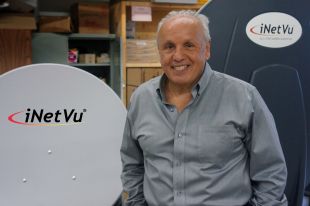Ottawa’s C-COM Satellite Systems has developed new technology that could eventually replace its current iNetVu® antenna and massively open up its customer base, CEO Leslie Klein told OBJ on Friday.
C-COM developed the technology, which one professor is calling the “Holy Grail of the intelligent antenna community,” in conjunction with the University of Waterloo.
C-COM has sold 7,000 iNetVu® antennas in more than 100 countries around the world, said Mr. Klein. But he said the current technology is “communication on the pause.”
In other words, a vehicle can’t use the antenna if it is moving.
“What we have announced is a development that changes that entire concept and allows a vehicle to be in full motion and be able to do the same thing,” said Mr. Klein.
Mr. Klein said current technology is mechanical – it rotates the antenna to be in contact with the satellite. The new technology uses electronic meta-materials to do the rotating, which is much faster than the mechanical method.
This basically fools the satellite into believing the vehicle is not actually moving, said Mr. Klein.
He said the new technology will be less expensive to produce, and therefore will be more affordable for customers – eventually.
“Some of these (current) antennas for the military cost hundreds of thousands of dollars and we are talking about tens of thousands of dollars. And ultimately, just thousands of dollars and at some point hundreds of dollars to make it available to the masses,” he said.
Mr. Klein said one day, this type of antenna could be on the roof of every car on the road.
“We’re also talking about trains, buses, transport vehicles, ultimately, you can have planes … this technology will ultimately be available and deployable in practically anything that moves,” he said.
Mr. Klein said there is not enough bandwidth to provide the Internet connectivity required by the masses.
“This would complement and enhance dramatically the Internet delivery of Internet-type of services into vehicles and other moveable structures that at the moment is just not possible,” he said.
And all the patents and intellectual property will belong to C-COM.
“Hopefully, all the shareholders of the company will benefit from this type of breakthrough,” said Mr. Klein.
For now, however, the research and development continues. Mr. Klein said a beta trial product should be on the market next year. He said C-COM and the University of Waterloo will continue refining the technology with an eye on making it more and more affordable.
Mr. Klein called the new technology a win-win for everyone involved. The federal and provincial governments provided some funding for the research and will see a good return when the military and police forces can acquire cheaper satellite options. Many students at the University of Waterloo, Mr. Klein’s alma mater, are working towards their PhDs through the research.

